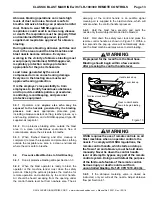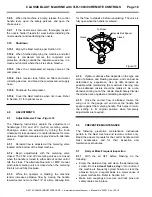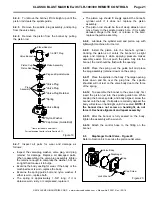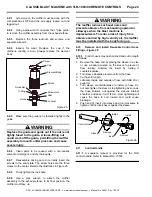
CLASSIC BLAST MACHINE with TLR-100/300 REMOTE CONTROLS
Page 13
© 2018 CLEMCO INDUSTRIES CORP.
www.clemcoindustries.com
Manual No. 22501, Rev. I 02/18
Abrasive blasting operations can create high
levels of dust and noise. No dust is safe to
breathe. Abrasive blasting can produce harmful
dust. Failure to wear NIOSH-approved
respirators could result in serious lung disease
or death. The respirators must be properly fitted
and maintained NIOSH-approved, type-CE
supplied-air respirators approved for abrasive
blasting.
During abrasive blasting, abrasive particles and
dust in the area around the blast machine and
blast nozzle become airborne. Everyone
working in the vicinity of abrasive blasting must
wear properly maintained, NIOSH-approved,
respiratory protection and eye protection
appropriate for the job site hazards.
Loud noise generated by the use of
compressed air can cause hearing damage.
Everyone in the blasting area must wear
approved hearing protection.
It is the employer’s responsibility to train
employees to identify hazardous substances
and to provide suitable policies, procedures,
monitoring, recordkeeping, and personal
protective equipment.
3.3.1
Operators
and
anyone else who may be
exposed to the hazards generated by the blasting
process
must wear appropriate protective gear,
including abrasive-resistant clothing, leather gloves, eye
and hearing protection, and a NIOSH-approved type-CE
supplied-air respirator.
3.3.2
Don protective blasting attire outside the blast
area in a clean nonhazardous environment, free of
contaminants, where the air is safe to breathe.
3.3.3
When finished blasting and after cleanup is
completed, remove the respirator and protective clothing
outside the respirator-use area in a clean environment
where the air is safe to breathe.
3.4
Pressurize Blast Machine to Start Blasting
3.4.1
Don all protective blasting attire per Section 3.3.
3.4.2
When the blast operator is ready to blast, the
operator or the machine tender must close the safety
petcock. Closing the petcock prepares the machine for
remote operation and activation by the control handle.
Air should be heard escaping from the opening under
the control handle lever but from nowhere else. The air
escaping at the control handle is an audible signal
meaning air is supplied to the blast machine, which will
activate when the control handle is pressed.
3.4.3
Hold the blast hose securely and point the
nozzle only toward objects intended to be blasted.
3.4.4
Fold down the safety lever lock and press the
remote control handle as shown in Figure 13. Within a
few seconds the pop-up valve will automatically close,
and the blast machine will pressurize to start blasting.
WARNING
Be prepared for the recoil from the blast hose.
Blasting should begin within a few seconds
after pressing the control handle lever.
Figure
13
WARNING
OSHA requires the use of remote controls on all
blast machines when an operator controls the
nozzle. To comply with OSHA regulations, the
remote control handle, which starts and stops
the flow of air and abrasive, must be held down
manually. Never tie down the control handle
lever or attempt to bypass any part of the remote
control system. Doing so will defeat the purpose
of the fail-to-safe feature of the remote control.
Serious injury or death could result from
uncontrolled blasting. Ref. 29 CFR 1910.244 (b).
3.4.5
If the abrasive metering valve is closed as
instructed, only air will exit the nozzle. Adjust abrasive
flow per Section 4.1.
Handle locked up
Fold lever lock down
Press control handle
down to begin blasting
Lever lock up















































